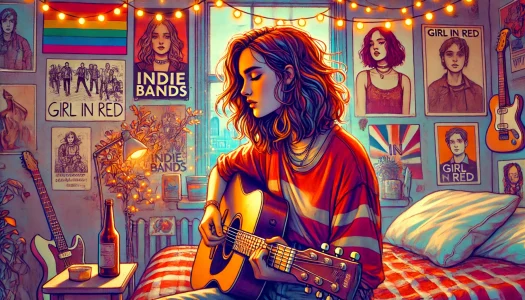If there’s an artist who has captured the raw, unfiltered essence of Gen Z’s inner emotional landscape, it’s girl in red. With her hauntingly honest lyrics, intimate bedroom-pop sound, and unapologetic queer identity, she has become a voice for a generation navigating love, mental health, and self-discovery. From viral Tumblr posts to international tours, girl in red—real name Marie Ulven—has created a space in the indie music scene where vulnerability is celebrated and being “different” feels like the new normal.
Background
Early Life
Marie Ulven, better known by her stage name girl in red, was born on February 16, 1999, in the small town of Horten, Norway. Growing up in a quiet, suburban environment, Marie spent much of her childhood surrounded by nature and solitude, which would later play a role in her introspective songwriting. Raised primarily by her mother, she found herself turning to creative outlets early on, whether through drawing, writing, or expressing herself through music. Marie often felt like an outsider in school, struggling with her sexuality in a conservative community, which fueled the themes of self-identity and longing that dominate her later work.
Her personal struggles with mental health and her journey to accepting her queerness have been critical influences on her music. These experiences gave her a deeper understanding of the importance of self-expression, setting the foundation for her candid and emotionally raw approach to songwriting.
Musical Beginnings
Marie’s musical journey began at a young age when she first picked up a guitar given to her by her grandfather. Initially, music was a private passion—a way to cope with the emotional turbulence of adolescence. However, it wasn’t long before she started experimenting with songwriting, pouring her thoughts and feelings into the music she created in the privacy of her bedroom. At 17, she downloaded GarageBand, the same platform that would become central to her signature lo-fi sound, and began producing her own tracks. This DIY ethic became a hallmark of her work, emphasizing raw emotion over polish, which resonated with listeners who craved authenticity.
In 2016, she posted her first track, “I Wanna Be Your Girlfriend,” on SoundCloud. The song, a heartfelt confession of unrequited love for another girl, quickly gained traction, earning her a dedicated fanbase almost overnight. Her vulnerable lyrics, combined with the simplicity of her homemade beats, struck a chord with listeners, especially within the LGBTQ+ community. As her music spread across platforms like YouTube and Spotify, Marie realized she had the potential to reach people far beyond her small town in Norway. The online virality of “I Wanna Be Your Girlfriend” marked the beginning of girl in red’s ascent to indie stardom.
Artistic Influences
Marie’s sound is a mix of lo-fi indie pop and soft rock, with heavy influences from both the music she grew up listening to and the emotional landscape she navigates. She cites artists like Taylor Swift, Kacey Musgraves, and Lorde as key inspirations for her songwriting style—particularly their ability to tell intimate stories through song. But the DIY aesthetic and raw production of artists like Tame Impala and King Krule also inspired her early forays into producing her own music.
Beyond individual artists, girl in red’s music is also influenced by the cultural movements of bedroom pop and indie rock, genres that thrive on a sense of intimacy and emotional vulnerability. Her lyrical themes often explore love, mental health, and queer identity, with a level of honesty that recalls the confessional songwriting of Elliott Smith and Phoebe Bridgers. However, girl in red brings a more youthful, often rebellious energy, mixing soft, melancholic moments with upbeat melodies that embody the emotional rollercoaster of young adulthood. Her sound is dynamic, blending quiet introspection with explosive bursts of emotion, making her a unique voice in modern indie pop.
Album Overview
Chapter 1 (2018)

girl in red first introduced herself to the world through her debut EP, Chapter 1, a six-track collection that set the tone for her signature lo-fi bedroom pop sound. Released in 2018, the EP explores themes of longing, identity, and mental health, all wrapped in a haze of fuzzy guitars and DIY production. The standout track, “I Wanna Be Your Girlfriend,” is a bold declaration of queer love that resonated with fans worldwide and helped catapult her into the indie spotlight. Tracks like “Summer Depression” and “4am” reflect the emotional intensity and isolation of youth, capturing the struggles of growing up in a way that felt both personal and universal.
The raw, unfiltered nature of Chapter 1 solidified girl in red’s reputation for creating music that felt like an intimate conversation between friends. Her ability to combine melancholic lyricism with upbeat, catchy melodies gave her songs a unique contrast, drawing in listeners with relatable stories and emotional depth. The EP laid the foundation for her burgeoning career, establishing her as a new voice in the indie pop scene.
Chapter 2 (2019)

Following the success of Chapter 1, girl in red released Chapter 2 in 2019, expanding on the themes of emotional turmoil and self-reflection while experimenting with a more polished sound. The six-track EP features fan favorites like “Dead Girl in the Pool” and “Bad Idea!”, which showcase her evolution as a songwriter and producer. While her signature bedroom pop style remains intact, there is a noticeable progression in the production quality and sonic experimentation, with more refined arrangements and intricate layers of sound.
In Chapter 2, girl in red delves deeper into her struggles with mental health, exploring anxiety, depression, and the often-destructive nature of love. Songs like “I’ll Die Anyway” are brutally honest reflections on existential dread, while tracks like “Bad Idea!” capture the impulsive nature of young love with playful energy. The EP serves as a bridge between her early DIY work and the more expansive sound that would come on her debut album, showing her growth as an artist while staying true to the raw vulnerability that made her music resonate.
If I Could Make It Go Quiet (2021)

girl in red’s debut full-length album, If I Could Make It Go Quiet, released in April 2021, marked a significant shift in her musical journey. While still rooted in the emotional transparency that defined her earlier work, this album sees her embracing a bolder, more expansive sound, blending indie rock, pop, and electronic elements. With collaborations from Grammy-winning producer FINNEAS (best known for his work with Billie Eilish), the album has a richer, more dynamic production, showcasing a maturation in both songwriting and sound.
If I Could Make It Go Quiet is an intense exploration of love, heartbreak, and self-destructive tendencies, with tracks like “Serotonin” diving into the complexities of mental illness, intrusive thoughts, and Marie’s personal struggles with anxiety. The song’s frenetic energy and sharp lyricism marked a new high in her ability to convey raw emotion. Meanwhile, songs like “Midnight Love” and “You Stupid Bitch” delve into the darker sides of relationships, capturing the messy, painful realities of unrequited love and toxic dynamics.
This album also reflects her growth as a public figure and artist, with a more polished, yet still deeply personal, approach. While some critics noted the shift towards a more mainstream sound, girl in red’s core emotional intensity and lyrical vulnerability remained central to her music, ensuring that her message continued to resonate with fans both old and new.
Industry Perspective
Challenges and Triumphs
Like many emerging artists, girl in red has faced her share of challenges on her rise to stardom. One of the most significant hurdles she encountered early in her career was navigating the music industry as a fiercely independent artist. Her DIY approach—producing, writing, and recording much of her early work in her bedroom—meant that she had to do everything herself, from marketing her music to managing her growing fanbase. Though this independence gave her full creative control, it also presented logistical difficulties, especially as her popularity began to surge.
Another challenge was the pressure of being labeled a “queer icon” in the media and music world. While girl in red has embraced her identity as a queer artist, she has been candid about the difficulties of being pigeonholed into this one aspect of her identity. The pressure to represent the LGBTQ+ community can be overwhelming, especially when critics and fans alike expect her music to continually address these themes. This expectation has sometimes clashed with her desire to explore other facets of life and artistry beyond her sexuality.
On the mental health front, Marie has been open about her struggles with anxiety, depression, and intrusive thoughts—issues that she addresses in her music. In many ways, music has been both a coping mechanism and a form of catharsis for her, but the intense emotional toll of balancing personal challenges with public life has not been easy. Despite these hurdles, girl in red has triumphed through her resilience, staying true to her authentic voice and using her music as a platform to advocate for mental health awareness and self-acceptance.
Collaborations and Connections
girl in red’s career has largely been characterized by her independence, but she has forged notable collaborations that have helped her expand her sound and reach. One of her most high-profile collaborations was with FINNEAS, who co-produced several tracks on her debut album, If I Could Make It Go Quiet. Working with FINNEAS, who is best known for his work with his sister Billie Eilish, brought a new layer of professionalism and polish to her sound, without losing the raw emotionality that had endeared her to fans. This partnership was pivotal in helping her transition from the DIY lo-fi aesthetic of her early releases to the more expansive, cinematic quality of her debut album.
Beyond individual collaborations, girl in red has become part of a larger indie and bedroom pop movement that includes artists like Clairo, Cavetown, and Beabadoobee. These artists, like Marie, have gained recognition by tapping into the emotional experiences of youth and utilizing the accessibility of platforms like SoundCloud and Bandcamp to reach their audience. This loose collective of like-minded musicians has helped shape the genre’s rise in recent years, creating a sense of community and shared values that reflect the DIY ethos of the early 2000s indie rock scene.
girl in red’s online presence has also been crucial in building connections with her fanbase, using social media platforms like Instagram and TikTok to interact directly with fans. Her hashtag, “#DoYouListenToGirlInRed”, became an internet shorthand for identifying queer women, further establishing her influence and impact within the LGBTQ+ community. This strong online connection with her audience is part of what keeps her grounded and attuned to the voices of her listeners.
Recognition and Achievements
Though still early in her career, girl in red has achieved significant milestones that underscore her rising star status. Her music has been streamed over a billion times across platforms, a remarkable achievement for an artist who began by uploading tracks from her bedroom. Her song “I Wanna Be Your Girlfriend” became a viral hit, amassing millions of streams and establishing her as a breakout star in the indie scene.
Critical acclaim has followed, particularly with the release of If I Could Make It Go Quiet. The album received praise from major publications such as NME, The Guardian, and Pitchfork, with critics lauding her ability to blend introspective lyricism with larger-than-life production. “Serotonin,” the lead single from the album, was particularly celebrated for its raw exploration of mental health, and it earned her spots on major festival lineups and television performances.
girl in red’s influence has extended beyond just streaming numbers and media buzz. She was nominated for and won several awards, including a Spellemannprisen (often called the “Norwegian Grammy”) for her debut album. In addition to industry accolades, she has been featured in Forbes’ “30 Under 30” list, marking her as one of the most influential young artists in music today. Her cultural impact, especially within the LGBTQ+ community, continues to grow, with girl in red being hailed as a voice for a generation that values authenticity, emotional transparency, and breaking down societal norms.
Impact and Legacy
Cultural Significance
girl in red has redefined what it means to be an indie artist in the 21st century, making a substantial cultural impact through her unfiltered exploration of love, mental health, and queer identity. Her music transcends the typical boundaries of the bedroom pop genre, speaking directly to the struggles and experiences of Gen Z. By infusing her songs with candid lyrics about mental health, existential dread, and the complexities of being queer, Marie Ulven has become a powerful voice in both the indie music scene and the broader cultural landscape.
What sets girl in red apart is not just her musical style, but the way she’s reshaped the conversation around queerness in pop music. In a world where LGBTQ+ artists are often expected to either downplay or heavily market their identity, girl in red approaches her queerness as an inherent part of her art, without turning it into a marketing gimmick. Her hit single “I Wanna Be Your Girlfriend” became a viral anthem for queer youth, and she continues to be embraced as a symbol of authenticity and inclusivity. By normalizing same-sex love in her music, she’s helped create a space where queer stories are not niche but central to the pop conversation.
Her influence on the bedroom pop genre is equally significant. girl in red has proven that a DIY approach can yield immense success, inspiring a new wave of artists to follow her footsteps by creating music from home, releasing it online, and using social media to build their fanbase organically. She represents a shift in the music industry, where the lines between mainstream and indie are blurring, and artists are no longer dependent on major labels or traditional pathways to fame.
Fanbase and Community
The community that has formed around girl in red is more than just a fanbase—it’s a movement. Fans of her music often find solace in her raw, emotional storytelling, connecting deeply with her lyrics and the personal struggles she shares. For many, especially young people within the LGBTQ+ community, girl in red has provided not only a soundtrack to their lives but a sense of belonging. Her openness about her mental health struggles and queer identity has resonated with those who feel marginalized or misunderstood, and she has become a role model for those navigating their own journeys of self-acceptance.
The viral hashtag “#DoYouListenToGirlInRed” has become a cultural shorthand within the queer community, symbolizing a shared experience of self-discovery and belonging. Her strong presence on platforms like Instagram and TikTok has allowed her to cultivate an even deeper connection with fans. She often engages directly with her audience, responding to comments and sharing personal updates, making her feel approachable and real in a way that many pop stars don’t. This tight-knit relationship has helped her create a loyal and supportive community that feels more like a collective of friends than a distant fandom.
girl in red’s ability to make fans feel seen and heard, both through her music and her candid online persona, has been a key factor in her success. As her platform grows, so does her influence on her listeners, many of whom look to her not only for musical inspiration but for guidance in navigating their own emotional worlds.
Looking Forward
As girl in red’s career continues to evolve, her future trajectory looks bright and promising. She’s already proven her ability to grow as an artist, shifting from the lo-fi, bedroom-produced tracks of her early days to the more polished and expansive sound of If I Could Make It Go Quiet. If her current work is any indication, girl in red is poised to continue pushing boundaries, both sonically and thematically, while remaining true to the core authenticity that has always defined her music.
In terms of her legacy, girl in red has the potential to be remembered as a trailblazer not only in the indie pop world but also in the representation of queer stories in mainstream music. Her ability to merge deeply personal narratives with widely relatable emotions has already placed her in a unique position within the industry. As she matures, she may expand her lyrical focus and experiment with new musical styles, but her impact on modern pop’s emotional landscape will remain profound.
Looking ahead, it’s likely that girl in red will continue to be an influential voice for young people, particularly within the LGBTQ+ community. Her willingness to embrace vulnerability in her art, along with her commitment to authenticity, will likely ensure that her work endures beyond fleeting trends. Whether through future albums, collaborations, or even further activism around mental health and queer representation, girl in red’s career is one that will leave a lasting imprint on both her fans and the music industry at large.
Closing Thoughts
girl in red is more than just a rising star in indie pop—she’s a fearless storyteller who has managed to distill the complexities of love, mental health, and identity into songs that resonate deeply with a global audience. Her unfiltered, DIY approach has allowed her to connect with listeners in an era that craves authenticity, and her unapologetic exploration of queerness and mental health has provided a voice for those who feel marginalized or misunderstood. Marie Ulven’s journey from her bedroom in Norway to international acclaim speaks to the power of vulnerability in art and the importance of staying true to one’s self, no matter the pressures of the industry.
At a time when so much music feels polished to perfection, girl in red’s raw emotional honesty is a breath of fresh air, offering listeners not only relatable anthems but a sense of community and understanding. Whether through her candid lyrics, her deeply personal performances, or her online presence, girl in red is creating art that makes people feel seen—and in that lies her true impact.
